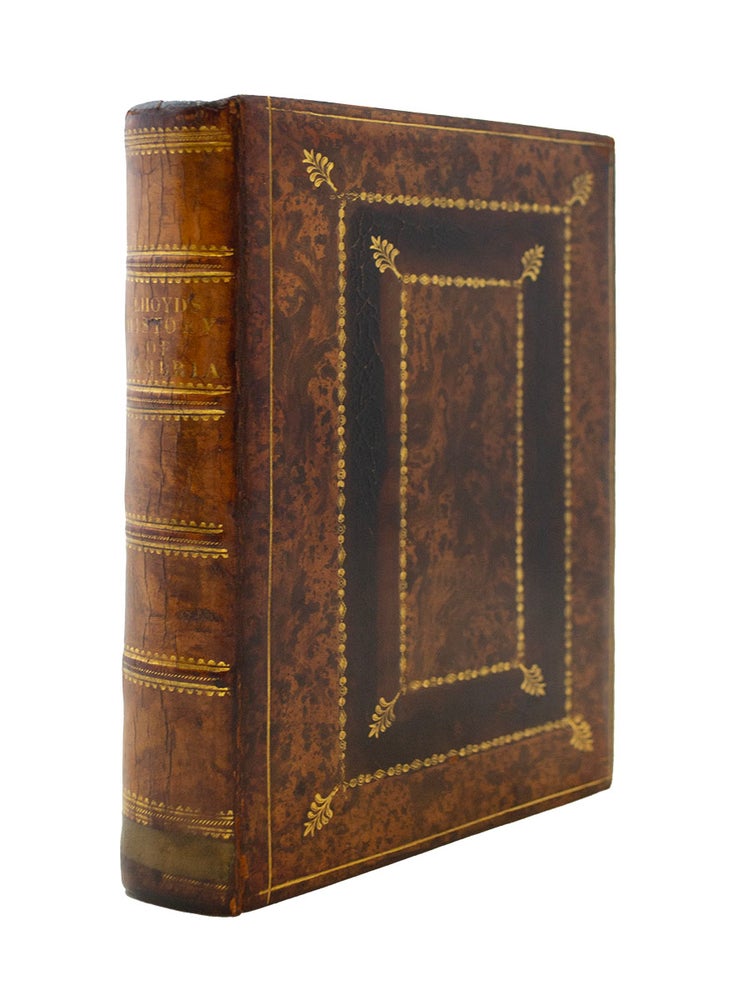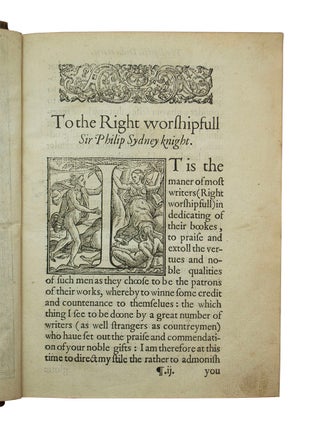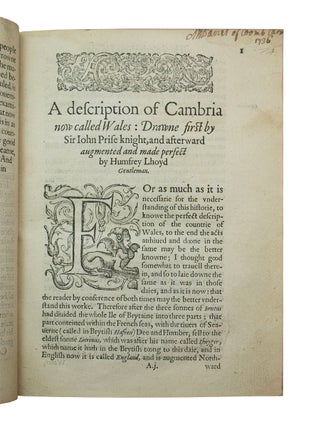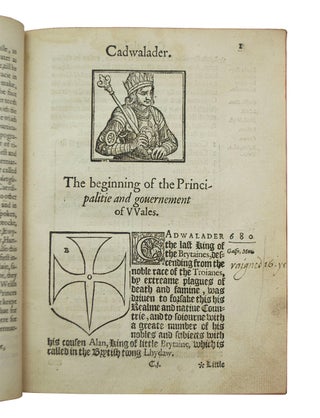The First Work to Claim The Welsh Discovered America Includes a Description of the Discovery of the Bones of King Arthur
Historie of Cambria. now called Wales: A part of the most famous Yland of Brytaine, written in the Brytish language aboue two hundreth yeares past. Translated into English by H. Lhoyd, and edited by David Powel.
London: Rafe Newberie and Henrie Denham, 1584.
Full description:
[CARADOC OF LLANCARFAN, Saint]. The Historie of Cambria. now called Wales: A part of the most famous Yland of Brytaine, written in the Brytish language aboue two hundreth yeares past. Translated into English by H. Lhoyd, and edited by David Powel. London: Rafe Newberie and Henrie Denham, 1584.
First edition of this rare and important history of Wales and Welsh royalty, illustrated throughout with woodcut portraits and woodcut frames for coats-of arms (presumably to be filled in by hand). Octavo (7 1/8 x 5 inches; 180 x 140 mm). [16], 22, 401, [1, errata], [12, table], [4, blank]. Without the blank at B4, but with the final blanks. Printed in Roman and black letter. Illustrated with woodcut portraits, title-page, initials (some historiated), tailpieces and printer's device.
This work was the first to attribute the original discovery of America to the Welsh in the 12th century and contains two very early references to King Arthur, including a description of the discovery of the bones of King Arthur and his queen.
Nineteenth-century paneled and mottled calf. Boards ruled and tooled in gilt. Spine stamped and lettered in gilt. All edges red. Marbled endpapers. Early ink marginalia. Some minor chipping to head of spine and a repair to bottom of spine. Outer joints a little worn. Leaf D5 with repair, touching text but with no loss. Leaf Q1 with a repair to bottom corner, but with no loss of text. Some soiling to a few leaves, namely F7-8, and pages 302-303. Leaves H4-5 trimmed short at fore-edge and bottom edge. Some occasional light dampstaining. Still a very good copy.
“The first and rarest of all the editions” (Sabin 40914) of this famous history of Wales and Welsh royalty from the 7th to 13th centuries and the “Princes of Wales of the blood royall of England” from Edward I to Elizabeth. Caradoc of Llancarfan, a 12th-century Welsh ecclesiastic and historian, “was a friend of Geoffrey of Monmouth, who at the conclusion of his famous ‘British History’ [one of the earliest and most important sources for the legends of King Arthur]... says: `The princes who afterwards ruled in Wales I committed to Caradog of Llancarvan, for he was my contemporary. And to him I gave the materials to write that book’... Caradog’s chief work [“Brut y Tywysogion”] was a sort of continuation of Geoffrey’s fictions from the beginning of really historical times down to his own day. In its original form Caradog’s chronicle is not now extant” (DNB). The work was translated into English in the 16th century by Humphrey Llwyd but remained in manuscript. David Powell (1552-1598), a Welsh historian, “was requested by Sir Henry Sidney, lord president of Wales, to prepare for the press an English translation... The work appeared, under the title ‘The History of Cambria,’ in 1584, with a curiously admonitory dedication to Sir Philip Sidney, the president’s son; though Llwyd’s translation was the basis, Powell’s corrections and additions, founded as they were on independent research, made the ‘Historie’ practically a new work... and later historians of Wales have to a large extent drawn their material from it” (DNB XVI: 238).
This work also contains two very early references to King Arthur. The first reference, on page 13, is a note about the creation of Glastonbury monastery on the Isle of Avalon by Ivor in the 7th century. According to St. Gildas, Joseph of Aramathea converted the Britains to Christianity “about the yeare of Christ 53” and built a church on the Isle of Avalon, “which Church, this Iuor... converted to an Abbey, and endowed the same with large possessions which was the more famous, because the bodies of the said Ioseph of Aramathia and King Arthur were there buried” (p. 13). This reference is presumably derived from Caradoc’s Vita Gildae (Life of St. Gildas), the first known text to associate King Arthur with Glastonbury, leading to the association of Glastonbury with Avalon. Lacy, 83. The second and more dramatic reference occurs on page 238, describing the discovery in 1179 of the bones of King Arthur and Guinevere: “This yeare the bones of noble king Arthur and Gwenhouar his wife were found in the Ile of Aualon, (that is to saie, the Ile of Aples) without the Abbie of Glastonburie, fifteene foote within the earth, in a holow elder tree, and ouer the bones was a stone and a crosse of lead, with a writing turned towards the stone, wherein were ingrauen these words. Hic iacet sepultus inclytus rex Arthurus in insula Aualonia. The bones were of marvelous bignes, and in the scull were ten wounds, of which one was great, and seemed to be his deaths wound: the Queenes haire was to the light faire and yellowe, but as soone as it was touched it fell to ashes...” (p. 238).
Of “special interest... for the American collector,” this was the first work to attribute the original discovery of America to a Welshman (Sabin 40914). “On page 227 begins a detailed account of the voyage of Madoc ap Owen Gwyneth to America in 1170, crediting that Welshman with the discovery of the New World. Montezuma told Cortez that he was descended from a group of white men who had come to Mexico many years before, and Caradoc claims that these were the followers of Madoc whom he left in America. A most interesting contribution to the pre-Columbian voyages of exploration, cited by Hakluyt” (Rosenbach 19: 107).
Sabin 40914
HBS 68939.
$9,000.
Price: $9,000.00
Item #68939





